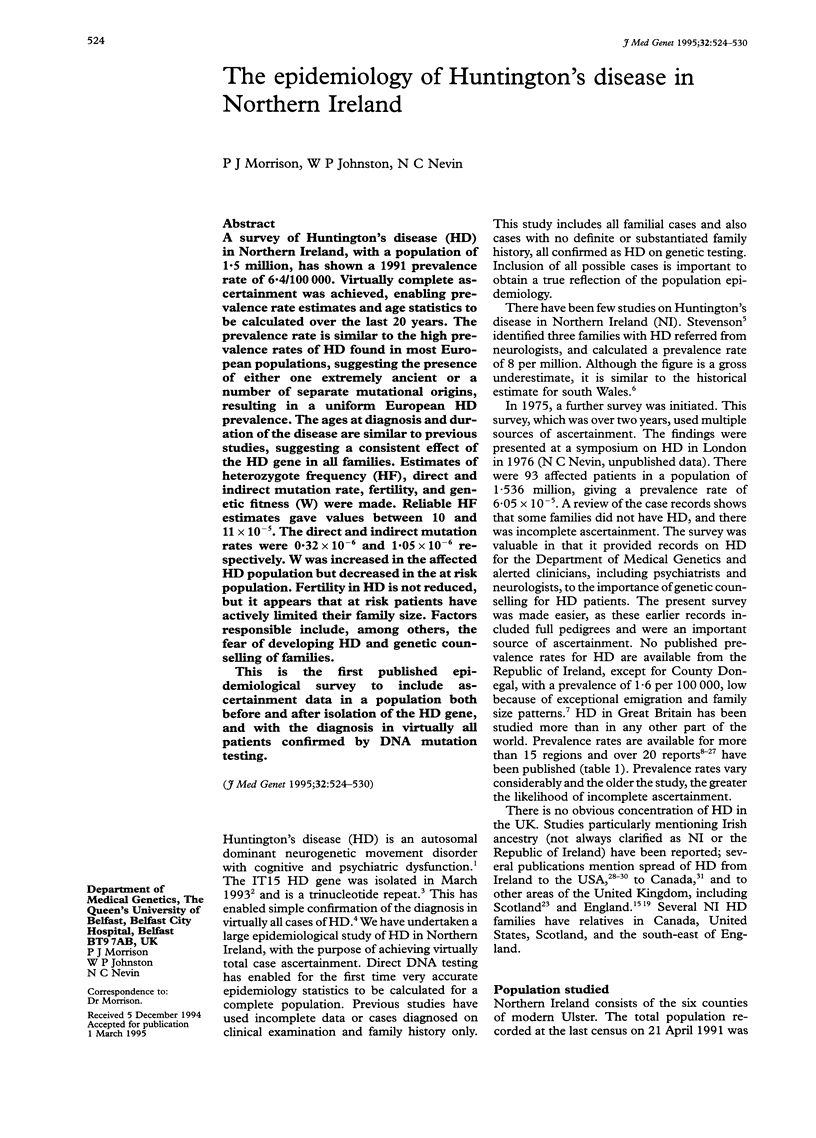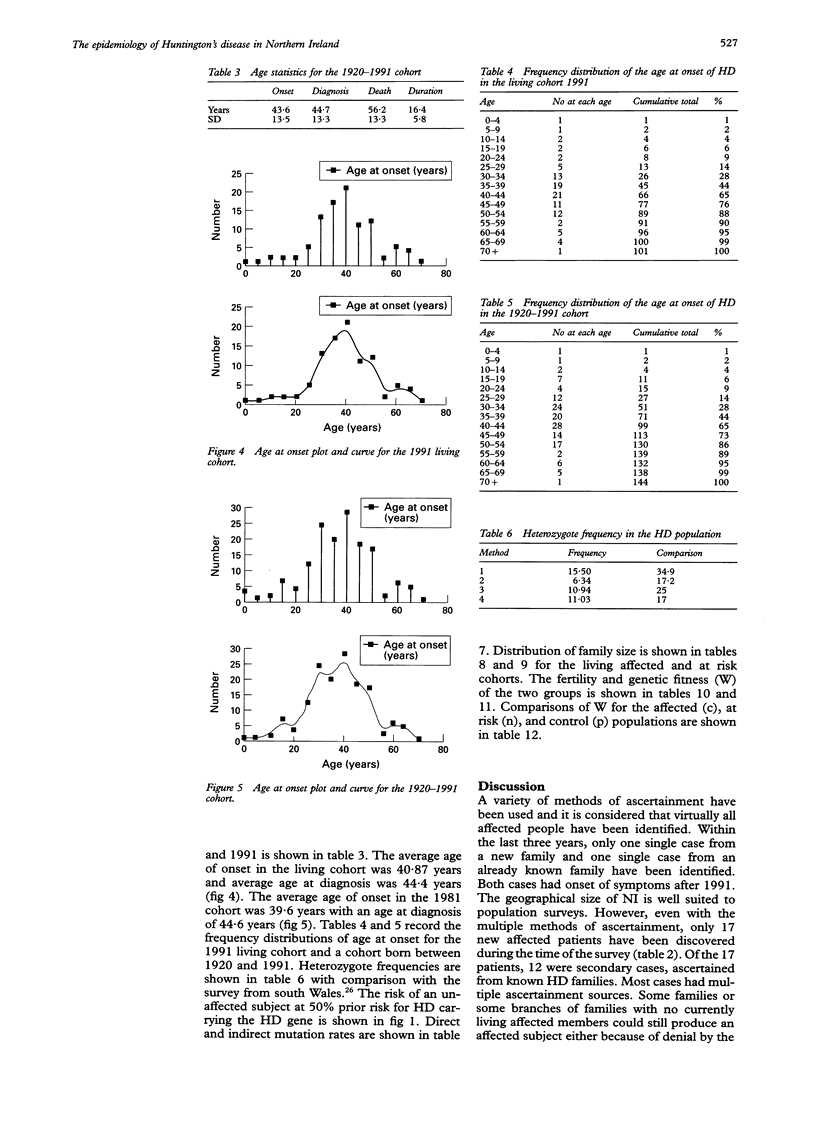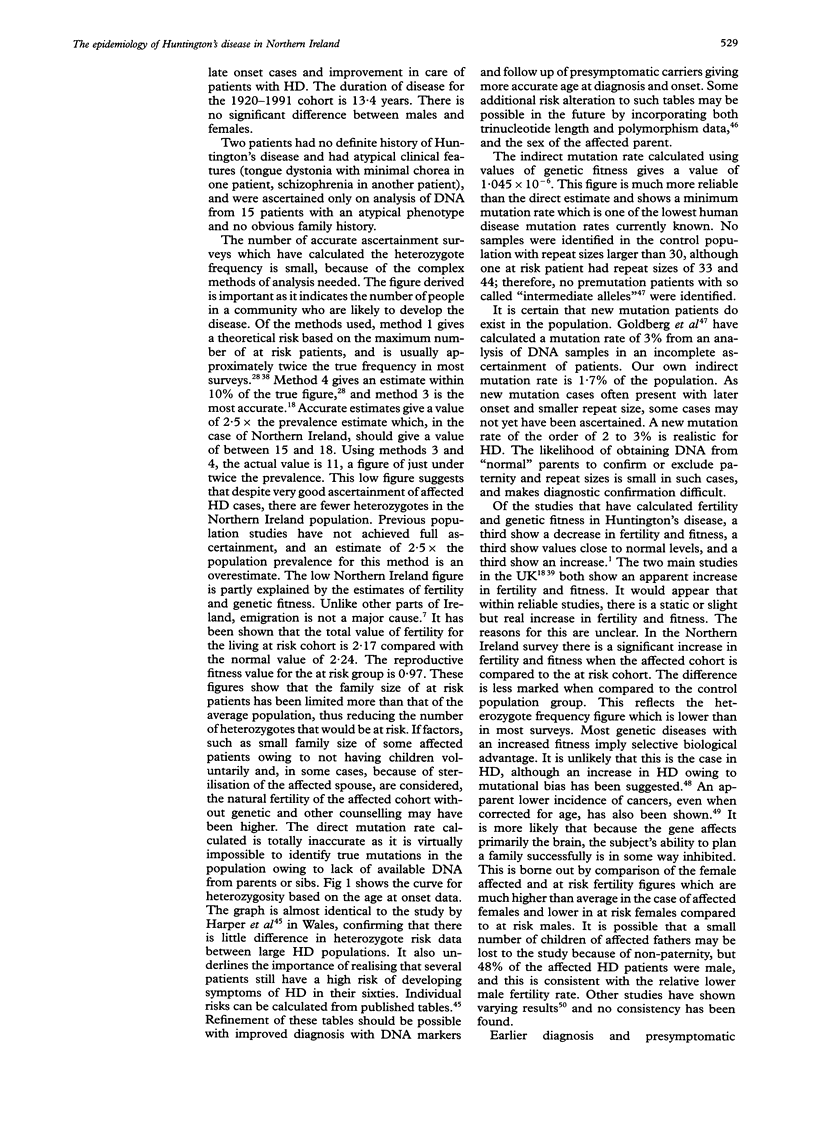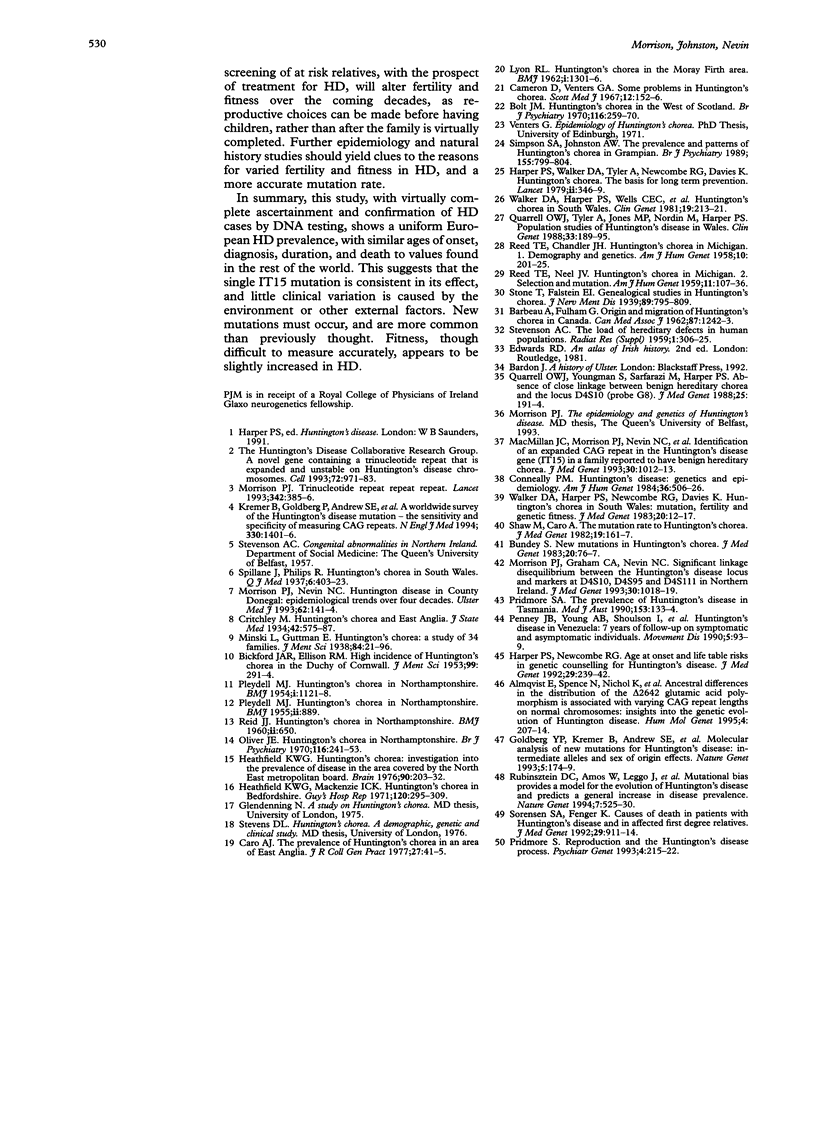Abstract
A survey of Huntington's disease (HD) in Northern Ireland, with a population of 1.5 million, has shown a 1991 prevalence rate of 6.4/100,000. Virtually complete ascertainment was achieved, enabling prevalence rate estimates and age statistics to be calculated over the last 20 years. The prevalence rate is similar to the high prevalence rates of HD found in most European populations, suggesting the presence of either one extremely ancient or a number of separate mutational origins, resulting in a uniform European HD prevalence. The ages at diagnosis and duration of the disease are similar to previous studies, suggesting a consistent effect of the HD gene in all families. Estimates of heterozygote frequency (HF), direct and indirect mutation rate, fertility, and genetic fitness (W) were made. Reliable HF estimates gave values between 10 and 11 x 10(-5). The direct and indirect mutation rates were 0.32 x 10(-6) and 1.05 x 10(-6) respectively. W was increased in the affected HD population but decreased in the at risk population. Fertility in HD is not reduced, but it appears that at risk patients have actively limited their family size. Factors responsible include, among others, the fear of developing HD and genetic counselling of families. This is the first published epidemiological survey to include ascertainment data in a population both before and after isolation of the HD gene, and with the diagnosis in virtually all patients confirmed by DNA mutation testing.
Full text
PDF






Selected References
These references are in PubMed. This may not be the complete list of references from this article.
- Almqvist E., Spence N., Nichol K., Andrew S. E., Vesa J., Peltonen L., Anvret M., Goto J., Kanazawa I., Goldberg Y. P. Ancestral differences in the distribution of the delta 2642 glutamic acid polymorphism is associated with varying CAG repeat lengths on normal chromosomes: insights into the genetic evolution of Huntington disease. Hum Mol Genet. 1995 Feb;4(2):207–214. doi: 10.1093/hmg/4.2.207. [DOI] [PubMed] [Google Scholar]
- BARBEAU A., FULLUM G. Origin and migration of Huntington's chorea in Canada: preliminary report. Can Med Assoc J. 1962 Dec 8;87:1242–1243. [PMC free article] [PubMed] [Google Scholar]
- BICKFORD J. A. R., ELLISON R. M. The high incidence of Huntington's chorea in the Duchy of Cornwall. J Ment Sci. 1953 Apr;99(415):291–294. doi: 10.1192/bjp.99.415.291. [DOI] [PubMed] [Google Scholar]
- Bolt J. M. Huntington's chorea in the West of Scotland. Br J Psychiatry. 1970 Mar;116(532):259–270. doi: 10.1192/bjp.116.532.259. [DOI] [PubMed] [Google Scholar]
- Bundey S. New mutations in Huntington's chorea. J Med Genet. 1983 Feb;20(1):76–77. doi: 10.1136/jmg.20.1.76. [DOI] [PMC free article] [PubMed] [Google Scholar]
- Cameron D., Venters G. A. Some problems in Huntington's chorea. Scott Med J. 1967 Apr;12(4):152–156. doi: 10.1177/003693306701200403. [DOI] [PubMed] [Google Scholar]
- Caro A. J. The prevalence of Huntington's chorea in an area of East Anglia. J R Coll Gen Pract. 1977 Jan;27(166):41–45. [PMC free article] [PubMed] [Google Scholar]
- Conneally P. M. Huntington disease: genetics and epidemiology. Am J Hum Genet. 1984 May;36(3):506–526. [PMC free article] [PubMed] [Google Scholar]
- Goldberg Y. P., Kremer B., Andrew S. E., Theilmann J., Graham R. K., Squitieri F., Telenius H., Adam S., Sajoo A., Starr E. Molecular analysis of new mutations for Huntington's disease: intermediate alleles and sex of origin effects. Nat Genet. 1993 Oct;5(2):174–179. doi: 10.1038/ng1093-174. [DOI] [PubMed] [Google Scholar]
- Harper P. S., Newcombe R. G. Age at onset and life table risks in genetic counselling for Huntington's disease. J Med Genet. 1992 Apr;29(4):239–242. doi: 10.1136/jmg.29.4.239. [DOI] [PMC free article] [PubMed] [Google Scholar]
- Harper P. S., Walker D. A., Tyler A., Newcombe R. G., Davies K. Huntington's chorea. The basis for long-term prevention. Lancet. 1979 Aug 18;2(8138):346–349. doi: 10.1016/s0140-6736(79)90356-8. [DOI] [PubMed] [Google Scholar]
- Heathfield K. W. Huntington's chorea. Investigation into the prevalence of this disease in the area covered by the North East Metropolitan Regional Hospital Board. Brain. 1967 Mar;90(1):203–232. doi: 10.1093/brain/90.1.203. [DOI] [PubMed] [Google Scholar]
- Heathfield K. W., Mackenzie I. C. Huntington's chorea in Bedfordshire, England. Guys Hosp Rep. 1971;120(4):295–309. [PubMed] [Google Scholar]
- Kremer B., Goldberg P., Andrew S. E., Theilmann J., Telenius H., Zeisler J., Squitieri F., Lin B., Bassett A., Almqvist E. A worldwide study of the Huntington's disease mutation. The sensitivity and specificity of measuring CAG repeats. N Engl J Med. 1994 May 19;330(20):1401–1406. doi: 10.1056/NEJM199405193302001. [DOI] [PubMed] [Google Scholar]
- LYON R. L. Huntington's chorea in the Moray Firth area. Br Med J. 1962 May 12;1(5288):1301–1306. doi: 10.1136/bmj.1.5288.1301. [DOI] [PMC free article] [PubMed] [Google Scholar]
- MacMillan J. C., Morrison P. J., Nevin N. C., Shaw D. J., Harper P. S., Quarrell O. W., Snell R. G. Identification of an expanded CAG repeat in the Huntington's disease gene (IT15) in a family reported to have benign hereditary chorea. J Med Genet. 1993 Dec;30(12):1012–1013. doi: 10.1136/jmg.30.12.1012. [DOI] [PMC free article] [PubMed] [Google Scholar]
- Morrison P. J., Graham C. A., Nevin N. C. Significant linkage disequilibrium between the Huntington's disease locus and markers at loci D4S10, D4S95, and D4S111 in Northern Ireland. J Med Genet. 1993 Dec;30(12):1018–1019. doi: 10.1136/jmg.30.12.1018. [DOI] [PMC free article] [PubMed] [Google Scholar]
- Morrison P. J., Nevin N. C. Huntington disease in County Donegal: epidemiological trends over four decades. Ulster Med J. 1993 Oct;62(2):141–144. [PMC free article] [PubMed] [Google Scholar]
- Morrison P. J. Trinucleotide repeat repeat repeat. Lancet. 1993 Aug 14;342(8868):385–386. doi: 10.1016/0140-6736(93)92809-8. [DOI] [PubMed] [Google Scholar]
- Oliver J. E. Huntington's chorea in Northamptonshire. Br J Psychiatry. 1970 Mar;116(532):241–253. doi: 10.1192/bjp.116.532.241. [DOI] [PubMed] [Google Scholar]
- PLEYDELL M. J. Huntington's chorea in Northamptonshire. Br Med J. 1954 Nov 13;2(4897):1121–1128. doi: 10.1136/bmj.2.4897.1121. [DOI] [PMC free article] [PubMed] [Google Scholar]
- PLEYDELL M. J. Huntington's chorea in Northamptonshire. Br Med J. 1955 Oct 8;2(4944):889–889. doi: 10.1136/bmj.2.4944.889. [DOI] [PMC free article] [PubMed] [Google Scholar]
- Penney J. B., Jr, Young A. B., Shoulson I., Starosta-Rubenstein S., Snodgrass S. R., Sanchez-Ramos J., Ramos-Arroyo M., Gomez F., Penchaszadeh G., Alvir J. Huntington's disease in Venezuela: 7 years of follow-up on symptomatic and asymptomatic individuals. Mov Disord. 1990;5(2):93–99. doi: 10.1002/mds.870050202. [DOI] [PubMed] [Google Scholar]
- Pridmore S. A. The prevalence of Huntington's disease in Tasmania. Med J Aust. 1990 Aug 6;153(3):133–134. doi: 10.5694/j.1326-5377.1990.tb136828.x. [DOI] [PubMed] [Google Scholar]
- Quarrell O. W., Tyler A., Jones M. P., Nordin M., Harper P. S. Population studies of Huntington's disease in Wales. Clin Genet. 1988 Mar;33(3):189–195. doi: 10.1111/j.1399-0004.1988.tb03436.x. [DOI] [PubMed] [Google Scholar]
- Quarrell O. W., Youngman S., Sarfarazi M., Harper P. S. Absence of close linkage between benign hereditary chorea and the locus D4S10 (probe G8). J Med Genet. 1988 Mar;25(3):191–194. doi: 10.1136/jmg.25.3.191. [DOI] [PMC free article] [PubMed] [Google Scholar]
- REED T. E., CHANDLER J. H. Huntington's chorea in Michigan. I. Demography and genetics. Am J Hum Genet. 1958 Jun;10(2):201–225. [PMC free article] [PubMed] [Google Scholar]
- REED T. E., NEEL J. V. Huntington's chorea in Michigan. 2. Selection and mutation. Am J Hum Genet. 1959 Jun;11(2 Pt 1):107–136. [PMC free article] [PubMed] [Google Scholar]
- REID J. J. Huntington's chorea in Northamptonshire. Br Med J. 1960 Aug 27;2(5199):650–650. doi: 10.1136/bmj.2.5199.650. [DOI] [PMC free article] [PubMed] [Google Scholar]
- Rubinsztein D. C., Amos W., Leggo J., Goodburn S., Ramesar R. S., Old J., Bontrop R., McMahon R., Barton D. E., Ferguson-Smith M. A. Mutational bias provides a model for the evolution of Huntington's disease and predicts a general increase in disease prevalence. Nat Genet. 1994 Aug;7(4):525–530. doi: 10.1038/ng0894-525. [DOI] [PubMed] [Google Scholar]
- Shaw M., Caro A. The mutation rate to Huntington's chorea. J Med Genet. 1982 Jun;19(3):161–167. doi: 10.1136/jmg.19.3.161. [DOI] [PMC free article] [PubMed] [Google Scholar]
- Simpson S. A., Johnston A. W. The prevalence and patterns of care of Huntington's chorea in Grampian. Br J Psychiatry. 1989 Dec;155:799–804. doi: 10.1192/bjp.155.6.799. [DOI] [PubMed] [Google Scholar]
- Sørensen S. A., Fenger K. Causes of death in patients with Huntington's disease and in unaffected first degree relatives. J Med Genet. 1992 Dec;29(12):911–914. doi: 10.1136/jmg.29.12.911. [DOI] [PMC free article] [PubMed] [Google Scholar]
- Walker D. A., Harper P. S., Newcombe R. G., Davies K. Huntington's chorea in South Wales: mutation, fertility, and genetic fitness. J Med Genet. 1983 Feb;20(1):12–17. doi: 10.1136/jmg.20.1.12. [DOI] [PMC free article] [PubMed] [Google Scholar]
- Walker D. A., Harper P. S., Wells C. E., Tyler A., Davies K., Newcombe R. G. Huntington's Chorea in South Wales. A genetic and epidemiological study. Clin Genet. 1981 Apr;19(4):213–221. doi: 10.1111/j.1399-0004.1981.tb00701.x. [DOI] [PubMed] [Google Scholar]


